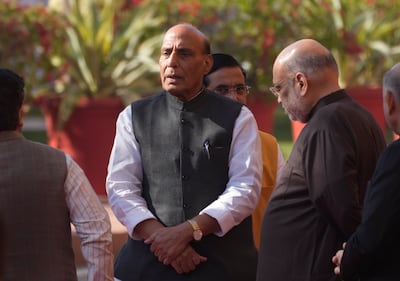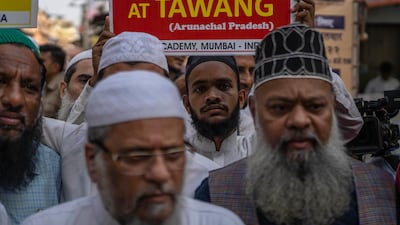The recent hand-to-hand brawl between Indian and Chinese soldiers has brought the Asian nuclear powers' festering border dispute back into focus, more than two years after the countries mobilised tens of thousands of troops following deadly clashes.
On Monday, Indian Defence Minister Rajnath Singh again accused China of attempting to unilaterally “change the status quo”, with Chinese People's Liberation Army alleging Indian forces had crossed the unmarked de facto Himalayan border.
Mr Singh told the Indian Parliament that the Chinese troops tried to enter the Yangtze region in Tawang Sector in Arunachal Pradesh in remote north-eastern India on December 9.
The soldiers of both sides reportedly fought with sticks and canes, with some suffering “minor injuries”.
It was the most serious clash on the disputed border since 2020 when the rival armies attacked each other with iron rods and clubs in Ladakh’s Galwan Valley along the undemarcated border — the Line of Actual Control.
India said 20 of its soldiers were killed in the latest clashes, while Beijing claimed four of its troops died.
What is the reason for the border dispute?
India and China share a nearly 4,000km undemarcated border known as Line of Actual Control (LAC). It traverses the mighty Himalayas and abuts Tibet and Xinjiang on the Chinese side, and Ladakh, Arunachal Pradesh and Sikkim states on the Indian side.
Arunachal Pradesh has been historically claimed by China as part of Tibet region. Last December, Beijing had renamed 15 places in the state.
The countries fought a deadly war over the disputed border in 1962, with Beijing briefly capturing parts of Arunachal Pradesh before unilaterally withdrawing its troops at the end of the conflict.
But the countries managed the border dispute in the coming decades except occasional clashes in late 60s before the 2020 fracas almost brought the countries to a brink of war.
The rival armies also clashed at Naku La area of North Sikkim last January.
In September last year, China accused India of firing shots at its troops, with New Delhi making similar allegations against Beijing.
A 1996 agreement prohibited the use of guns and explosives near the border.
How are Chinese-Indian relations?
The nuclear-powered nations have attempted to peacefully resolve the border disputes but diplomatic relations have remained strained since the Galwan incident in 2020, particularly due to the growing political tension between Indian Prime Minister Narendra Modi and his Chinese counterpart Xi Jinping.
Both countries held 16 rounds of a “frank” and “in-depth” exchange of views to resolve the dispute and agreed to disengage from contentious points.
While the troops completed disengagement from a key area in the disputed Eastern Ladakh region in September, many other potential flashpoints remain undisputed.
The Chinese forces continue to block access to traditional patrolling areas of the Indian military in the Depsang Plains and Charding Nala regions on the LAC.
Depsang Plains is a plateau at an altitude of 4,800m. Chinese troops are allegedly occupying an 18km area which India considers its own territory.
Beijing has consistently refused to accept those areas are Indian territory.
What was the response?
New Delhi has been aggressively enhancing its infrastructure along the border.
It opened the world's highest driveable road, a 52km stretch in Chisumle-Demchok to allow its troops faster access to the cold, rugged terrain last December.
It has also kick-started an extensive development campaign in the remote region to match Chinese military investment across the LAC, further irking Beijing.
Experts say India must deliver a considered response in the absence of bilateral talks to resolve the dispute.
“It was a relatively low-key level and once the Indian side responded they went back, but the second aspect is that this is an indication for escalation and can be repeated," Srikanth Kondapalli, professor of Chinese studies at New Delhi's Jawaharlal Nehru University, told The National.
“India needs a more concentrated response — political, diplomatic and military.”
The specs: 2017 Dodge Ram 1500 Laramie Longhorn
Price, base / as tested: Dhxxx
Engine: 5.7L V8
Transmission: Eight-speed automatic
Power: 395hp @ 5,600rpm
Torque: 556Nm @ 3,950rpm
Fuel economy, combined: 12.7L / 100km
Wayne Rooney's career
Everton (2002-2004)
- Appearances: 48
- Goals: 17
Manchester United (2004-2017)
- Appearances: 496
- Goals: 253
England (2003-)
- Appearances: 119
- Goals: 53
Bombshell
Director: Jay Roach
Stars: Nicole Kidman, Charlize Theron, Margot Robbie
Four out of five stars
MATCH INFO
Inter Milan 1 (Martinez 18' pen)
Juventus 2 (Dybala 4', Higuain 80')
WHAT%20IS%20'JUICE%20JACKING'%3F
%3Cp%3E%E2%80%A2%20Juice%20jacking%2C%20in%20the%20simplest%20terms%2C%20is%20using%20a%20rogue%20USB%20cable%20to%20access%20a%20device%20and%20compromise%20its%20contents%3C%2Fp%3E%0A%3Cp%3E%E2%80%A2%20The%20exploit%20is%20taken%20advantage%20of%20by%20the%20fact%20that%20the%20data%20stream%20and%20power%20supply%20pass%20through%20the%20same%20cable.%20The%20most%20common%20example%20is%20connecting%20a%20smartphone%20to%20a%20PC%20to%20both%20transfer%20data%20and%20charge%20the%20former%20at%20the%20same%20time%3C%2Fp%3E%0A%3Cp%3E%E2%80%A2%20The%20term%20was%20first%20coined%20in%202011%20after%20researchers%20created%20a%20compromised%20charging%20kiosk%20to%20bring%20awareness%20to%20the%20exploit%3B%20when%20users%20plugged%20in%20their%20devices%2C%20they%20received%20a%20security%20warning%20and%20discovered%20that%20their%20phones%20had%20paired%20to%20the%20kiosk%2C%20according%20to%20US%20cybersecurity%20company%20Norton%3C%2Fp%3E%0A%3Cp%3E%E2%80%A2%20While%20juice%20jacking%20is%20a%20real%20threat%2C%20there%20have%20been%20no%20known%20widespread%20instances.%20Apple%20and%20Google%20have%20also%20added%20security%20layers%20to%20prevent%20this%20on%20the%20iOS%20and%20Android%20devices%2C%20respectively%3C%2Fp%3E%0A
Our family matters legal consultant
Name: Hassan Mohsen Elhais
Position: legal consultant with Al Rowaad Advocates and Legal Consultants.
Common%20symptoms%20of%20MS
%3Cul%3E%0A%3Cli%3EFatigue%3C%2Fli%3E%0A%3Cli%3Enumbness%20and%20tingling%3C%2Fli%3E%0A%3Cli%3ELoss%20of%20balance%20and%20dizziness%3C%2Fli%3E%0A%3Cli%3EStiffness%20or%20spasms%3C%2Fli%3E%0A%3Cli%3ETremor%3C%2Fli%3E%0A%3Cli%3EPain%3C%2Fli%3E%0A%3Cli%3EBladder%20problems%3C%2Fli%3E%0A%3Cli%3EBowel%20trouble%3C%2Fli%3E%0A%3Cli%3EVision%20problems%3C%2Fli%3E%0A%3Cli%3EProblems%20with%20memory%20and%20thinking%3C%2Fli%3E%0A%3C%2Ful%3E%0A
Porsche Macan T: The Specs
Engine: 2.0-litre 4-cyl turbo
Power: 265hp from 5,000-6,500rpm
Torque: 400Nm from 1,800-4,500rpm
Transmission: 7-speed dual-clutch auto
Speed: 0-100kph in 6.2sec
Top speed: 232kph
Fuel consumption: 10.7L/100km
On sale: May or June
Price: From Dh259,900
Ruwais timeline
1971 Abu Dhabi National Oil Company established
1980 Ruwais Housing Complex built, located 10 kilometres away from industrial plants
1982 120,000 bpd capacity Ruwais refinery complex officially inaugurated by the founder of the UAE Sheikh Zayed
1984 Second phase of Ruwais Housing Complex built. Today the 7,000-unit complex houses some 24,000 people.
1985 The refinery is expanded with the commissioning of a 27,000 b/d hydro cracker complex
2009 Plans announced to build $1.2 billion fertilizer plant in Ruwais, producing urea
2010 Adnoc awards $10bn contracts for expansion of Ruwais refinery, to double capacity from 415,000 bpd
2014 Ruwais 261-outlet shopping mall opens
2014 Production starts at newly expanded Ruwais refinery, providing jet fuel and diesel and allowing the UAE to be self-sufficient for petrol supplies
2014 Etihad Rail begins transportation of sulphur from Shah and Habshan to Ruwais for export
2017 Aldar Academies to operate Adnoc’s schools including in Ruwais from September. Eight schools operate in total within the housing complex.
2018 Adnoc announces plans to invest $3.1 billion on upgrading its Ruwais refinery
2018 NMC Healthcare selected to manage operations of Ruwais Hospital
2018 Adnoc announces new downstream strategy at event in Abu Dhabi on May 13
Source: The National
Quick pearls of wisdom
Focus on gratitude: And do so deeply, he says. “Think of one to three things a day that you’re grateful for. It needs to be specific, too, don’t just say ‘air.’ Really think about it. If you’re grateful for, say, what your parents have done for you, that will motivate you to do more for the world.”
Know how to fight: Shetty married his wife, Radhi, three years ago (he met her in a meditation class before he went off and became a monk). He says they’ve had to learn to respect each other’s “fighting styles” – he’s a talk it-out-immediately person, while she needs space to think. “When you’re having an argument, remember, it’s not you against each other. It’s both of you against the problem. When you win, they lose. If you’re on a team you have to win together.”
if you go
The flights
The closest international airport to the TMB trail is Geneva (just over an hour’s drive from the French ski town of Chamonix where most people start and end the walk). Direct flights from the UAE to Geneva are available with Etihad and Emirates from about Dh2,790 including taxes.
The trek
The Tour du Mont Blanc takes about 10 to 14 days to complete if walked in its entirety, but by using the services of a tour operator such as Raw Travel, a shorter “highlights” version allows you to complete the best of the route in a week, from Dh6,750 per person. The trails are blocked by snow from about late October to early May. Most people walk in July and August, but be warned that trails are often uncomfortably busy at this time and it can be very hot. The prime months are June and September.
How Beautiful this world is!
box
COMPANY PROFILE
Company name: Letstango.com
Started: June 2013
Founder: Alex Tchablakian
Based: Dubai
Industry: e-commerce
Initial investment: Dh10 million
Investors: Self-funded
Total customers: 300,000 unique customers every month



